Meet the Vipers
Vipers (Viperidae) are often considered the most advanced family of snakes. All vipers are venomous and feature tubular fangs in the front of their mouths. The fangs are hinged and can be folded back when not needed. It is a sophisticated and efficient way of delivering venom to their bite victims.
All U.S. vipers are pit vipers. The “pit viper” nomenclature comes from the pair of loreal pits located between each of the snakes’ eyes and nostrils. These pits sense heat and allow these vipers to strike their victims with surgical precision.
While most vipers prefer to retreat rather than attack, they still account for 98% of all venomous snake bites in the United States.
Here are the 19 species of vipers in the United States.
1. Black-Tailed Rattlesnake (Crotalus molossus)
This black-tailed rattlesnake’s eponymous black-tipped tail ends at the rattle. The snake’s body is a vibrant yellow/yellow-green/yellow-brown.
This reptile lives in deserts, rocky areas, grasslands, and high-pine or boreal forests. It is highly adaptable to its surroundings. While this snake can thrive in a desert environment, it can easily climb trees.
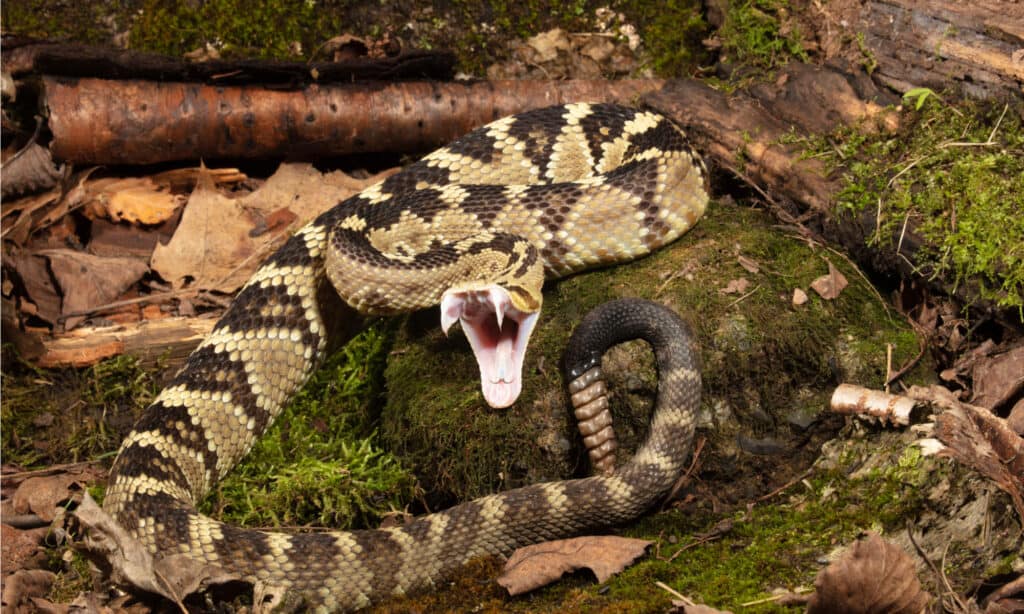
The black-tailed rattlesnake can be identified by its signature black tail.
©Joe McDonald/Shutterstock.com
2. Copperhead (Agkistrodon contortrix)
These snakes are spread widely throughout the eastern United States. While they are venomous (as are all vipers), their venom is less lethal to humans than other pit vipers. However, copperheads are also responsible for more snakebites to humans than any other snake in the U.S. This is not because the snake is overly aggressive. Rather, it happens mostly through accidental interactions. The copperhead population is quite large, and they camouflage perfectly with leaf litter and other environmental features. Many bite victims step on or very near a copperhead without ever seeing it.
The copperhead’s range covers much of the eastern, southern, and central United States. Human encounters often happen simply because the snake’s territorial range intersects with highly populated areas.

Copperheads account for more human bites than any other snake in the U.S.
©Jeff W. Jarrett/Shutterstock.com
3. Cottonmouth (Agkistrodon piscivorus)
The cottonmouth is also known as the water moccasin. Lesser-used names for the snake also include swamp moccasin, rusty moccasin, and black moccasin. All of these names refer to the same snake.
This highly-venomous pit viper is semi-aquatic and is almost always found near water bodies, including cypress swamps, wetlands, river floodplains, bays, and lakes. The cottonmouth’s range includes all of the southern United States and extends as far north as southern Illinois and Indiana.
The common “cottonmouth” name comes from the bright white coloration found inside the snake’s mouth. The snake is often mistaken for the northern water snake due to their similar appearance and shared aquatic habitat. However, while cottonmouths are venomous, northern water snakes are not.
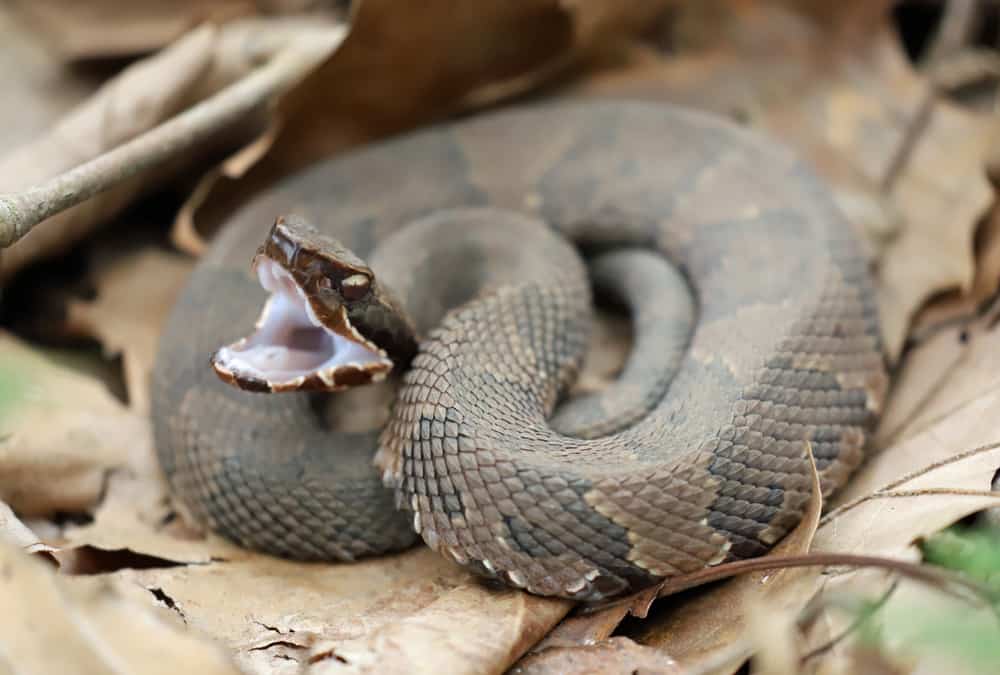
The cottonmouth is highly-venomous and is found throughout the southern U.S.
©KF2017/Shutterstock.com
4. Eastern Diamondback Rattlesnake (Crotalus adamanteus)
The eastern diamondback rattlesnake is the largest venomous snake in North America and the largest rattlesnake in the world. It is both an active hunter and an ambush predator. The snake can remain virtually still for as long as a week, waiting to strike. Talk about patience!
Found throughout the southern United States, human interactions with this snake can happen fairly frequently. The eastern diamondback is more dangerous to humans than the similarly named western diamondback rattlesnake. The eastern diamondback is likelier to stand its ground and strike rather than retreat.

The eastern diamondback rattlesnake is the largest rattlesnake in the world.
©Chase D’animulls/Shutterstock.com
5. Massasauga (Sistrurus catenatus)
This snake’s unique name comes from the Chippewa language, meaning “Great River Mouth.” It is pronounced “mass-a-saw-ga.” The massasauga is often mistaken for the fox snake, hognose snake, and eastern milk snake. Fox and milk snakes are non-venomous. Hognose snakes produce mild venom to subdue prey but pose no threat to humans.
The snake features multi-color markings, including gray, tan, or brown, with splotches of dark brown or black. They are not often seen because their camouflage can make them nearly invisible. Human interactions are still rare, as the snake would rather move away rather than confront a human. But, as with all of these vipers, the bite risk is not zero.

Massasaugas have colors and markings that include tan, gray, or brown with dark brown or black splotches, as seen on this juvenile.
©Rusty Dodson/Shutterstock.com
6. Mojave Rattlesnake (Crotalus scutulatus)
The Mojave rattlesnake is the most venomous rattlesnake in the world. The snake looks similar to the western diamondback rattlesnake, but it is far more lethal. This doesn’t mean the Mojave rattlesnake is overly-aggressive, though. In reality, the snake would much prefer to avoid a confrontation if at all possible.
The snake lives primarily in desert regions but can also be found in grasslands, shrublands, and forests. Mojave rattlesnake populations are stable, thanks in part to federally protected lands in their native habitats.
The snake features a triangular head with light brown to green coloration on its body. It also displays alternating white and black rings near its tail.

The Mojave rattlesnake is the world’s deadliest rattlesnake.
©Creeping Things/Shutterstock.com
7. Pacific Rattlesnake (Crotalus oreganus)
The Pacific rattlesnake is one of the most common rattlesnakes in the United States. The snake features seven subspecies found across the west coast and desert regions of the U.S. Those subspecies include:
- Grand Canyon Rattlesnake (Crotalus oreganus abyssus)
- Coronado Island Rattlesnake (Crotalus oreganus caliginis)
- Arizona Black Rattlesnake (Crotalus oreganus cerberus)
- Yellow Rattlesnake (Crotalus oreganus concolor)
- Southern Pacific Rattlesnake (Crotalus oreganus helleri)
- Great Basin Rattlesnake (Crotalus oreganus lutosus)
- Northern Pacific Rattlesnake (Crotalus oreganus oreganus)
Unlike most rattlesnakes whose numbers are contracting, some of the subspecies of the Pacific rattlesnake seem to be expanding in numbers and in their range.
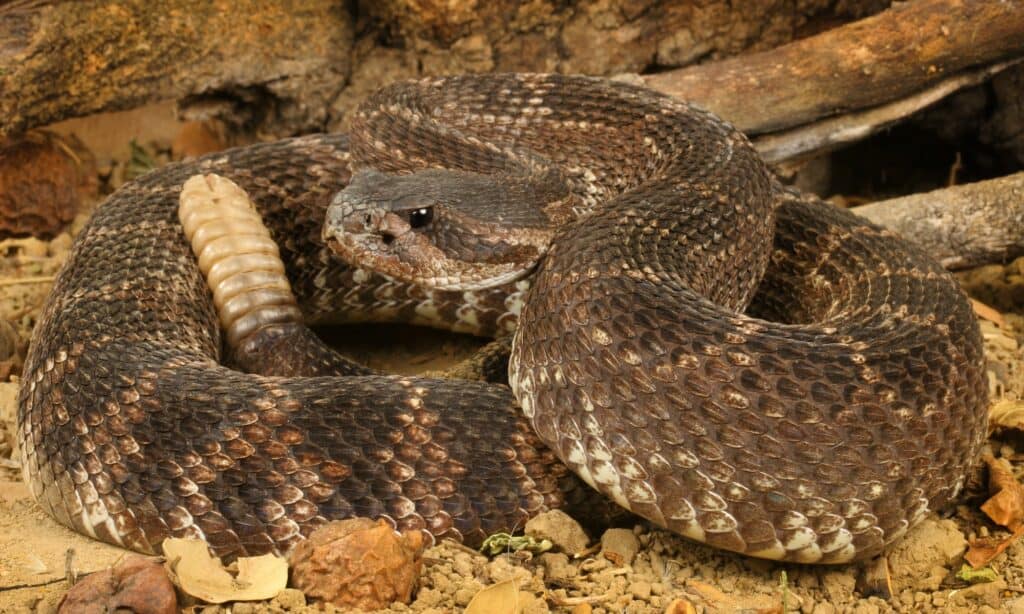
Pacific rattlesnakes are some of the most common in the U.S.
©iStock.com/johnaudrey
8. Panamint Rattlesnake (Crotalus stephensi)
Sometimes referred to as the Owen’s Valley rattler, the Panamint rattlesnake’s more common name comes from the Panamint Mountains in Death Valley National Park. This snake has a very limited range. It is found in California and Nevada between elevations of 3,000 and nearly 8,000 feet where it feeds on birds, lizards, and small mammals. The snake will sometimes move to lower desert elevations in cooler weather.
This snake was once considered a sub-species of the speckled rattlesnake. Researchers have since determined through DNA and morphology that this snake does not interbreed with the speckled rattlesnake. In 2007, the Panamint rattlesnake was elevated to its own species.

Panamint rattlesnakes are found in high elevations in California and Nevada.
©Marina Kehl/Shutterstock.com
9. Prairie Rattlesnake (Crotalus viridis)
The prairie rattlesnake is native to grasslands and arid regions throughout the central United States. The snake is highly venomous. But, while its bite is potentially lethal to humans, the prairie rattlesnake does not pose an inordinately high risk to people. As long as the snake is not cornered or provoked, it is not likely to strike a person.
Prairie rattlesnakes live in the plains, foothills, wooded areas, and arid environments east of the Rocky Mountains. These snakes are often confused with western diamondback rattlesnakes, but they are a separate species. Precise numbers are difficult to ascertain, but frequent sightings of prairie rattlesnakes indicate that the species is thriving.
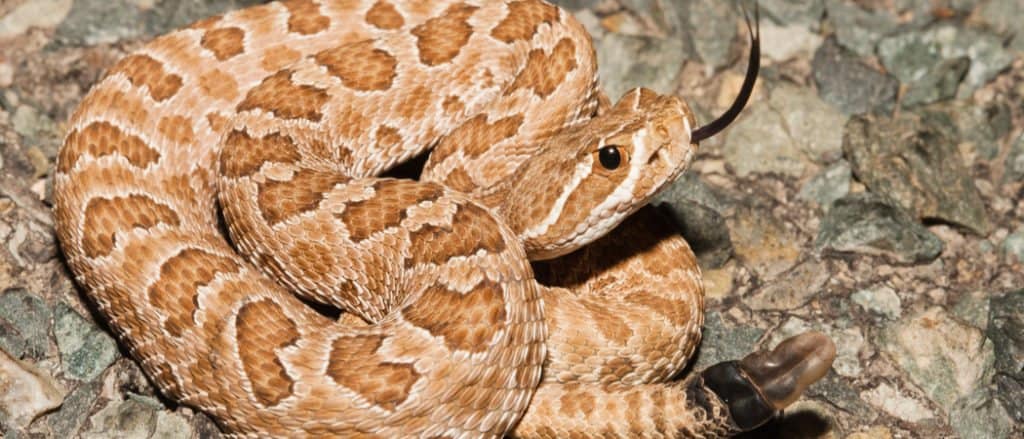
Prairie rattlesnake numbers appear to be healthy in the central U.S.
©Nathan A Shepard/Shutterstock.com
10. Pygmy Rattlesnake (Sistrurus miliarius)
As their name suggests, pygmy rattlesnakes are the smallest rattlesnake species in the United States. A mature pygmy rattlesnake will normally measure less than 24 inches long.
These snakes are also known as eastern pygmy rattlesnakes, ground rattlesnakes, leaf rattlers, or ground rattlers. These small rattlesnakes often hide in leaf litter, waiting to ambush their prey which includes birds, lizards, insects, frogs, and mice along with other small mammals. They have been known to prey on other snakes, as well.
Pygmy rattlesnakes inhabit a variety of environments including swamps, moist lowlands, sandhills, mixed forests, wet prairies, and floodplains. They are found throughout the southeastern United States.
The pygmy rattlesnake’s small size and excellent camouflage can lead to bites on humans who are unaware of their presence. Their venom is less potent and is delivered in smaller amounts than other vipers. It is highly unlikely that a pygmy rattlesnake bite would be fatal for an adult human.
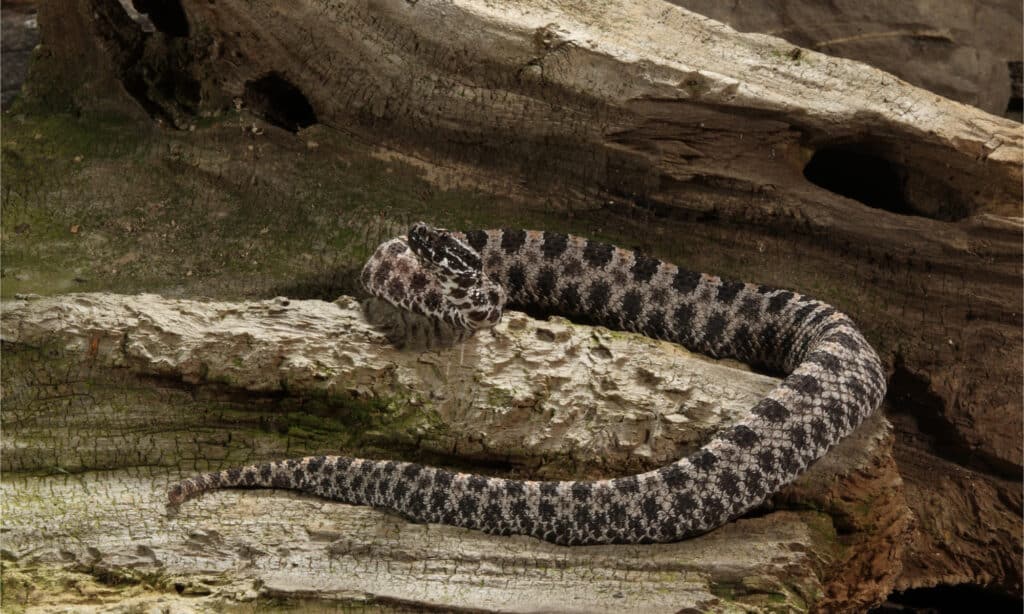
Pygmy rattlesnakes are the smallest rattlesnakes in the U.S., growing only 24 inches long.
©Dennis W Donohue/Shutterstock.com
11. Red Diamond Rattlesnake (Crotalus ruber)
The red diamondback rattlesnake can be found in a variety of habitats, including coastal scrub brush, desert slopes, rocky canyons, lower woodlands, and even cultivated fields.
The snake features diamond-shaped blotches along the length of its back, as do eastern and western diamondbacks, hence their name. The red diamondback rattlesnake features a reddish tinge that is missing from the other two diamondback rattlesnakes.
Red diamondback rattlesnakes are normally ambush predators, blending into their surroundings and waiting for a mouse, rat, rabbit, lizard, or another prey animal to happen by. Bites on humans are rare and normally happen because the snake was stepped on or otherwise startled.

Red diamondback rattlesnakes are ambush predators.
©Creeping Things/Shutterstock.com
12. Ridge-Nosed Rattlesnake (Crotalus willardi)
The ridge-nosed rattlesnake is the most recently discovered species of rattlesnake in the United States. The snake was not documented until 1905. The snake’s delayed discovery was largely due to its remote habitat. The ridge-nosed rattlesnake lives in the rugged and isolated mountain region of the Sky Islands in Mexico and Arizona.
Ridge-nosed rattlesnakes are ambush predators, preying mostly on small mammals, lizards, birds, and large centipedes. Given their elusive nature and their remote habitat, human encounters with the snake are exceedingly rare.
This snake is also known as the Willard’s rattler or Willard’s rattlesnake. Those common names, along with the snake’s scientific name, are in honor of the person who discovered the snake, Professor Frank C. Willard.

The ridge-nosed rattlesnake was first documented in the U.S. in 1905.
©Matt Jeppson/Shutterstock.com
13. Rock Rattlesnake (Crotalus lepidus)
One snake with many names, the rock rattlesnake is also referred to as the blue rattlesnake, green rattlesnake, white rattlesnake, eastern rock rattlesnake, and Texas rock rattlesnake.
This snake is found in the southwestern United States. It inhabits rock crevices, outcrops, rock slides, as well as coniferous forests.
The snake is abundant in Texas but is considered a threatened species in New Mexico. This is largely due to habitat loss in New Mexico, while the snake’s habitat in Texas is more remote and less accessible for development.
Rock rattlesnakes are not aggressive and will generally avoid human confrontations if possible. There have been no documented human fatalities from rock rattlesnake bites. That’s not to say that the bites do not cause many serious and painful health problems requiring immediate medical attention, though.
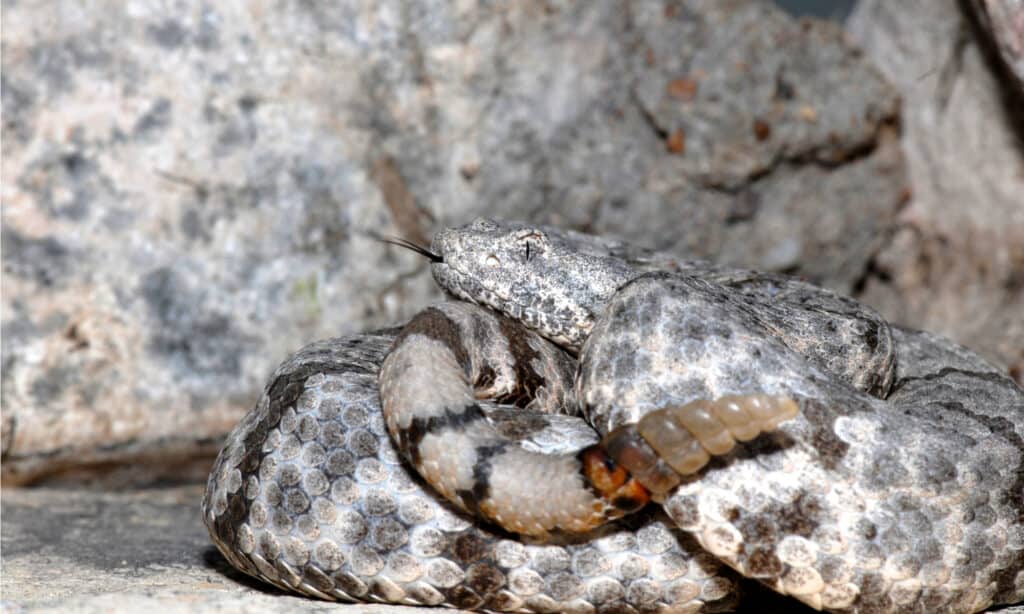
Rock rattlesnakes blend in with their rocky environments, allowing them to ambush prey.
©Rusty Dodson/Shutterstock.com
14. Sidewinder (Crotalus cerastes)
This snake’s name comes from its curious but very efficient means of locomotion. Most snakes slither along the ground. Their bodies may have a curving motion, but they usually move in a straight line. Not the sidewinder!
As its name suggests, the sidewinder leads with its mid-sections instead of its heads, walking or “winding” its way along. It may sound clumsy, but it is just the opposite. Sidewinders can move up to 18 mph, making it the fastest snake in the world.
This sideways gait doesn’t just give the snake extraordinary speed. It also limits how much of its body is in contact with the hot sand of its desert environment at any one time.
Because the snake features horn-like structures on its head, it is sometimes known as the horned rattlesnake.

Sidewinders get their name from their unique form of side-stepping locomotion, which is an adaptation for moving across loosely packed desert sands.
©Roger de Montfort/Shutterstock.com
15. Speckled Rattlesnake (Crotalus mitchellii)
The speckled rattlesnake is so-named due to its speckled appearance. The snake’s exact patterns will vary, but these snakes will always feature specks that help them blend in with the with gritty sand or rocks of their desert habitat.
The snake is found in the U.S. Southwest. It is primarily an ambush predator, lying motionless and waiting for a small mammal, bird, or lizard to come close.
Due to its timid nature and remote habitat, human encounters with the speckled rattlesnake are rare. When bites do occur, the venom causes a myriad of painful health problems, but it is almost never lethal.
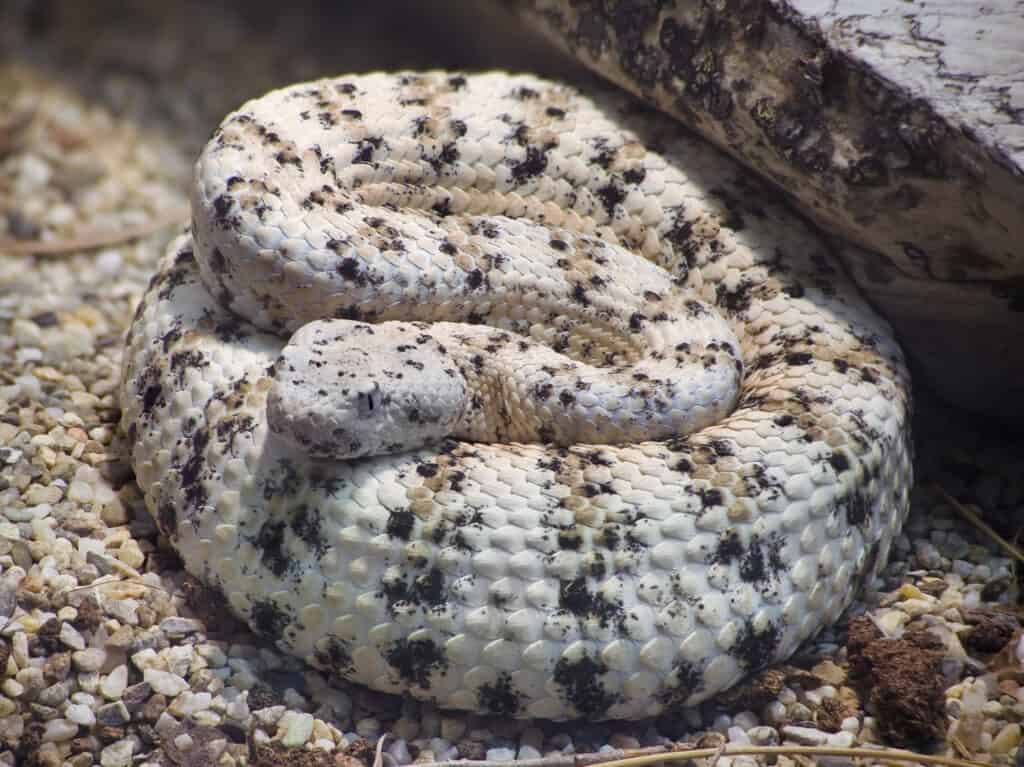
The Speckled Rattlesnake colors help it to blend into the rocks in its native desert habitat.
©Dario Sabljak/Shutterstock.com
16. Tiger Rattlesnake (Crotalus tigris)
This highly venomous snake stalks the rocky hills of Arizona and Mexico. The tiger rattlesnake has the smallest head of any rattlesnake, allowing it to pull its prey from rock crevices and other tight spaces.
The snake’s range is very limited. An individual tiger rattlesnake may not cover more than a 1.5-square-mile range in its lifetime.
The venom of the tiger rattlesnake is deadly, perhaps trailing only the Mojave rattlesnake as the most dangerous of all North American vipers for humans. The snake’s venom is a lethal cocktail of neuro- and mycotoxins that cause tissue damage and paralysis. Thankfully, due to their remote habitat and the snake’s reclusive nature, tiger rattlesnake bites on humans are uncommon.
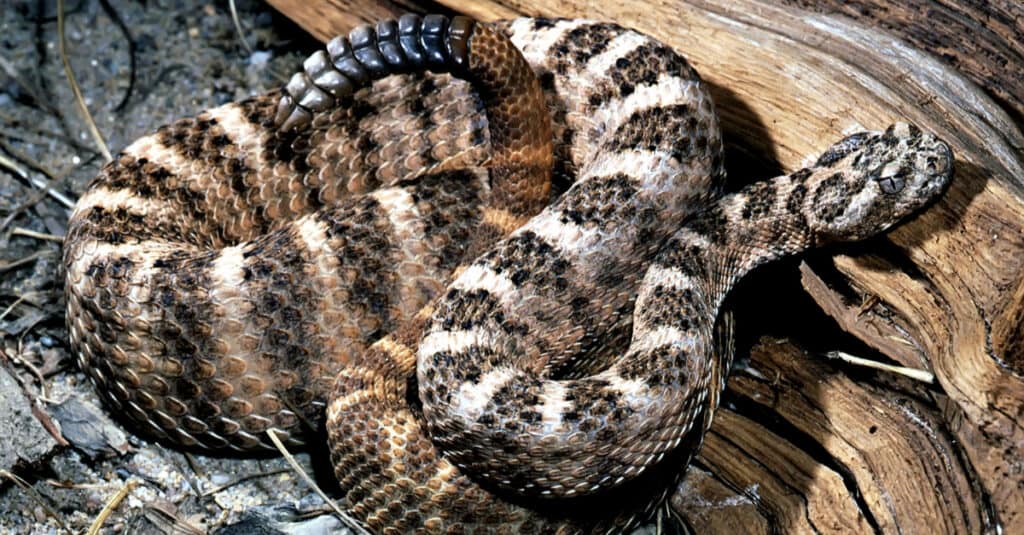
Tiger
rattlesnakes have smaller heads relative to their bodies than other rattlesnakes.
©Vladislav T. Jirousek/Shutterstock.com
17. Timber Rattlesnake (Crotalus horridus)
The timber rattlesnake is also known as the canebrake rattlesnake, black rattlesnake, American viper, banded rattlesnake, and eastern rattlesnake. Whatever name you prefer, this snake is one of the most common venomous snakes in the eastern United States.
The snake inhabits hardwood forests, swamps, farm fields, and rocky hills. Its prey of choice includes small mammals, birds, and amphibians.
Timber rattlesnakes are not overly aggressive, which is fortunate since human encounters are much higher than many other vipers. They prefer to warn off intruders through rattling rather than initiating a strike. When a rare bite does occur, swift medical attention is needed. While the venom is almost never lethal, it does cause painful swelling and neurological symptoms. The venom also prevents a wound from closing, so excessive bleeding is a concern.
The timber rattlesnake is featured on the well-known Gadsden Flag along with the words, “DON’T TREAD ON ME.” The timber rattlesnake was named the official state reptile of West Virginia in 2008.
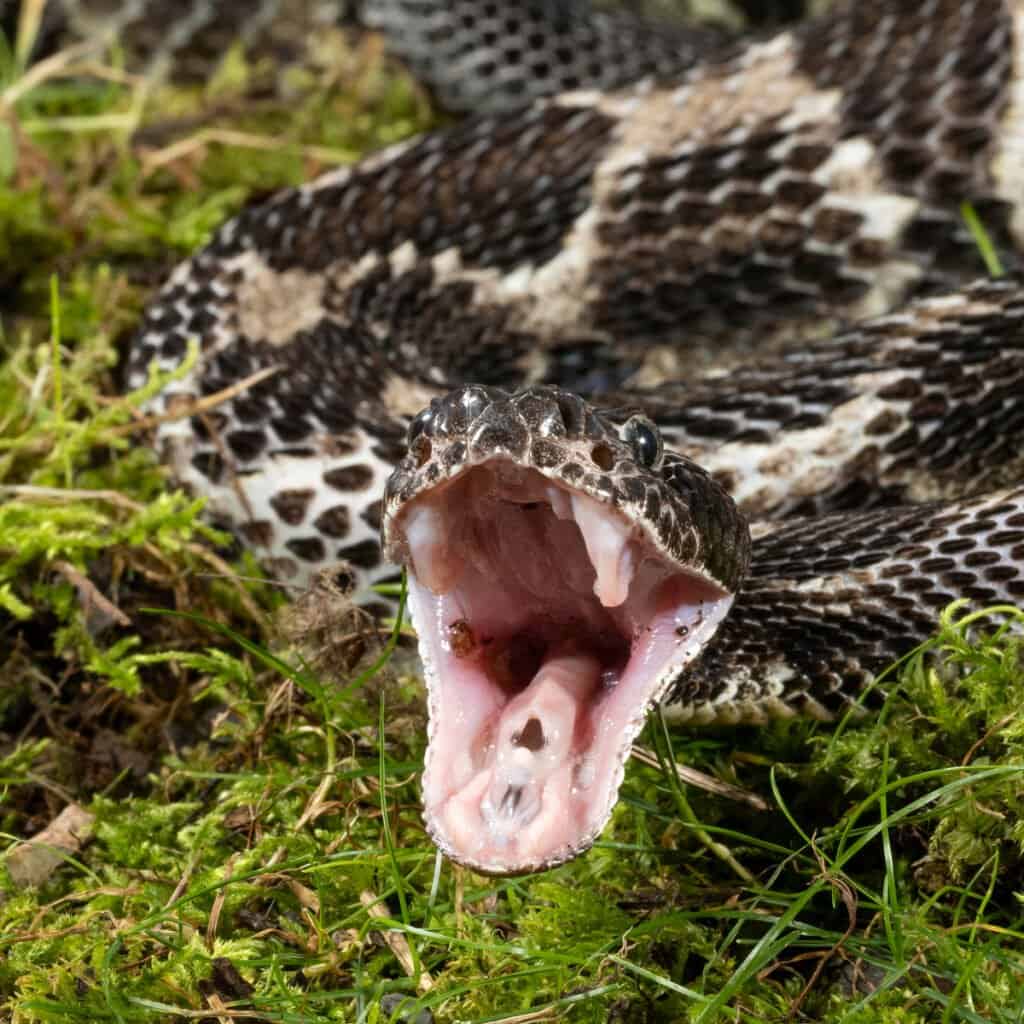
Timber rattlesnakes live in more populated areas than many other vipers, leading to more human encounters.
©Joe McDonald/Shutterstock.com
18. Twin-Spotted Rattlesnake (Crotalus pricei)
The twin-spotted rattlesnake is named for the double rows of spots on its back. While not quite as small as the pygmy rattlesnake, the twin-spotted rattlesnake is one of the smallest rattlesnake species. At maturity, the snake will measure 20-24 inches long.
Human interactions are rare because this snake inhabits high elevations in mountains and deserts. They dwell among rocky slopes, scree, bare rock, and sometimes in coniferous forests and grassy areas. They are seldom found at an elevation below 6,000 feet and can inhabit elevations as high as 10,000 feet.
This small rattlesnake can inflict a painful and harmful bite, but it is highly unlikely that it would be fatal to an adult human.
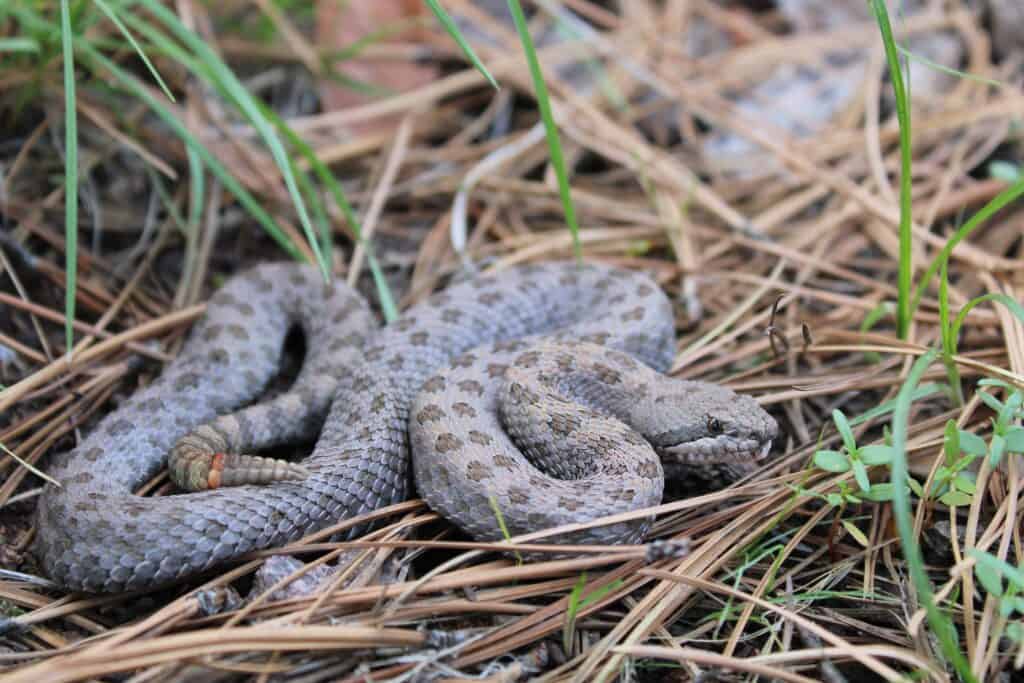
Twin-spotted rattlesnakes are named for their dual-spotted appearance.
©Tucker Heptinstall/Shutterstock.com
19. Western Diamondback Rattlesnake (Crotalus atrox)
The western diamondback rattlesnake is one of the most well-known of all the North American vipers, partially due to its use in Hollywood westerns. The snake’s population is thriving in the American Southwest, although habitat loss is a concern in some parts of its range.
Human encounters are much higher than many other vipers, given how the snake’s territory and human development overlap. Bites on humans are more common than many other vipers.
The western diamondback rattlesnake will stand its ground and strike if it feels threatened, although, as with most of the snakes on this list, it would prefer the perceived threat back away rather than engaging it through a strike.
Rattlesnake roundups still happen from time to time in populated areas. While it may make humans feel safer, it harms the ecosystem when predators are removed in large numbers. Western diamondback rattlesnakes are important for rodent control, as well as the population of other small mammals.

Bites from western diamondback rattlesnakes happen more frequently than many other U.S. vipers.
©Alexander Wong/Shutterstock.com
Now that you know the vipers that inhabit the United States, which ones might you encounter in your area? Here’s a list of the vipers that can be found in each U.S. state.
Alabama – 5 Viper Species
- Copperhead
- Cottonmouth
- Eastern Diamondback Rattlesnake
- Pygmy Rattlesnake
- Timber Rattlesnake
Alaska – 0 Viper Species
There are no snakes of any species native to Alaska.
Arizona – 12 Viper Species
- Blacktail Rattlesnake
- Massasauga
- Mojave Rattlesnake
- Pacific Rattlesnake
- Prairie Rattlesnake
- Ridge-nosed Rattlesnake
- Rock Rattlesnake
- Sidewinder
- Speckled Rattlesnake
- Tiger Rattlesnake
- Twin-Spotted Rattlesnake
- Western Diamondback Rattlesnake
Arkansas – 5 Viper Species
- Copperhead
- Cottonmouth
- Pygmy Rattlesnake
- Timber Rattlesnake
- Western Diamondback Rattlesnake
California – 7 Viper Species
- Mojave Rattlesnake
- Pacific Rattlesnake
- Panamint Rattlesnake
- Red Diamond Rattlesnake
- Sidewinder
- Speckled Rattlesnake
- Western Diamondback Rattlesnake
Colorado – 4 Viper Species
- Massasauga
- Mojave Rattlesnake
- Pacific Rattlesnake
- Prairie Rattlesnake
Connecticut – 2 Viper Species
- Copperhead
- Timber Rattlesnake
Delaware – 2 Viper Species
- Copperhead
- Timber Rattlesnake
Florida – 5 Viper Species
- Copperhead
- Cottonmouth
- Eastern Diamondback Rattlesnake
- Pygmy Rattlesnake
- Timber Rattlesnake
Georgia – 5 Viper Species
- Copperhead
- Cottonmouth
- Eastern Diamondback Rattlesnake
- Pygmy Rattlesnake
- Timber Rattlesnake
Hawaii – 0 Viper Species
There are no vipers native to Hawaii.
Idaho – 1 Viper Species
- Prairie Rattlesnake
Illinois – 4 Viper Species
- Copperhead
- Cottonmouth
- Massasauga
- Timber Rattlesnake
Indiana – 4 Viper Species
- Copperhead
- Cottonmouth
- Massasauga
- Timber Rattlesnake
Iowa – 4 Viper Species
- Copperhead
- Massasauga
- Prairie Rattlesnake
- Timber Rattlesnake
Kansas – 6 Viper Species
- Copperhead
- Cottonmouth
- Massasauga
- Prairie Rattlesnake
- Pygmy Rattlesnake
- Timber Rattlesnake
Kentucky – 4 Viper Species
- Copperhead
- Cottonmouth
- Pygmy Rattlesnake
- Timber Rattlesnake
Louisiana – 5 Viper Species
- Copperhead
- Cottonmouth
- Eastern Diamondback Rattlesnake
- Pygmy Rattlesnake
- Timber Rattlesnake
Maine – 0 Viper Species
There are no vipers native to Maine.
Maryland – 2 Viper Species
- Copperhead
- Timber Rattlesnake
Massachusetts – 2 Viper Species
- Copperhead
- Timber Rattlesnake
Michigan – 1 Viper Species
- Massasauga
Minnesota – 2 Viper Species
- Massasauga
- Timber Rattlesnake
Mississippi – 5 Viper Species
- Copperhead
- Cottonmouth
- Eastern Diamondback Rattlesnake
- Pygymy Rattlesnake
- Timber Rattlesnake
Missouri – 5 Viper Species
- Copperhead
- Cottonmouth
- Massasauga
- Pygmy Rattlesnake
- Timber Rattlesnake
Montana – 1 Viper Species
- Prairie Rattlesnake
Nebraska – 4 Viper Species
- Copperhead
- Massasauga
- Prairie Rattlesnake
- Timber Rattlesnake
Nevada – 6 Viper Species
- Pacific Rattlesnake
- Panamint Rattlesnake
- Prairie Rattlesnake
- Sidewinder
- Speckled Rattlesnake
- Western Diamondback Rattlesnake
New Hampshire – 1 Viper Species
- Timber Rattlesnake
New Jersey – 2 Viper Species
- Copperhead
- Timber Rattlesnake
New Mexico – 6 Viper Species
- Blacktail Rattlesnake
- Massasauga
- Prairie Rattlesnake
- Ridge-nosed Rattlesnake
- Rock Rattlesnake
- Western Diamondback Rattlesnake
New York – 3 Viper Species
- Copperhead
- Massasauga
- Timber Rattlesnake
North Carolina – 5 Viper Species
- Copperhead
- Cottonmouth
- Eastern Diamondback Rattlesnake
- Pygymy Rattlesnake
- Timber Rattlesnake
North Dakota– 1 Viper Species
- Prairie Rattlesnake
Ohio – 3 Viper Species
- Copperhead
- Massasauga
- Timber Rattlesnake
Oklahoma – 7 Viper Species
- Copperhead
- Cottonmouth
- Massasauga
- Prairie Rattlesnake
- Pygmy Rattlesnake
- Timber Rattlesnake
- Western Diamondback Rattlesnake
Oregon – 2 Viper Species
- Pacific Rattlesnake
- Prairie Rattlesnake
Pennsylvania – 3 Viper Species
- Copperhead
- Massasauga
- Timber Rattlesnake
Rhode Island – 0 Viper Species
There are no vipers native to Rhode Island.
South Carolina – 4 Viper Species
- Copperhead
- Cottonmouth
- Eastern Diamondback Rattlesnake
- Pygymy Rattlesnake
South Dakota – 1 Viper Species
- Prairie Rattlesnake
Tennessee – 4 Viper Species
- Copperhead
- Cottonmouth
- Pygmy Rattlesnake
- Timber Rattlesnake
Texas – 10 Viper Species
- Black-tailed Rattlesnake
- Copperhead
- Cottonmouth
- Massasauga
- Mojave Rattlesnake
- Prairie Rattlesnake
- Pgymy Rattlesnake
- Rock Rattlesnake
- Timber Rattlesnake
- Western Diamondback Rattlesnake
Utah – 6 Viper Species
- Mojave Rattlesnake
- Pacific Rattlesnake
- Prairie Rattlesnake
- Sidewinder
- Speckled Rattlesnake
- Timber Rattlesnake
Vermont – 1 Viper Species
- Timber Rattlesnake
Virginia – 3 Viper Species
- Copperhead
- Cottonmouth
- Timber Rattlesnake
Washington – 2 Viper Species
- Prairie Rattlesnake
- Western Rattlesnake
West Virginia – 2 Viper Species
- Copperhead
- Timber Rattlesnake
Wisconsin – 2 Viper Species
- Massasauga
- Timber Rattlesnake
Wyoming – 2 Viper Species
- Prairie Rattlesnake
- Western Rattlesnake
The photo featured at the top of this post is © iStock.com/Chase D'animulls
Discover the "Monster" Snake 5X Bigger than an Anaconda
Every day A-Z Animals sends out some of the most incredible facts in the world from our free newsletter. Want to discover the 10 most beautiful snakes in the world, a "snake island" where you're never more than 3 feet from danger, or a "monster" snake 5X larger than an anaconda? Then sign up right now and you'll start receiving our daily newsletter absolutely free.
Thank you for reading! Have some feedback for us? Contact the AZ Animals editorial team.







